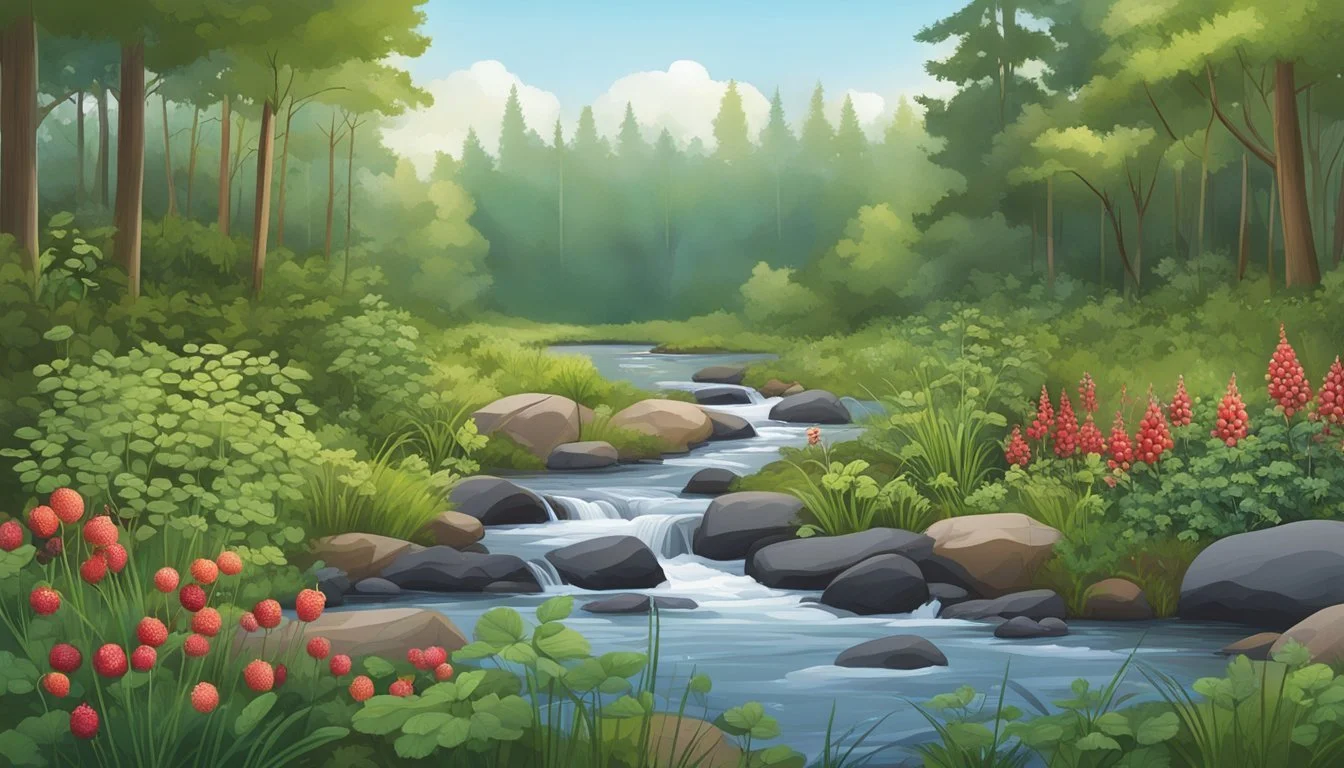New England Native Edible Plants
A Guide to Foraging and Cooking
In the verdant landscapes of New England, a variety of native plants offer both beauty and sustenance. Enthusiasts and foragers alike can discover an array of edible plants that thrive in the region's diverse ecosystems. From the nutrient-rich blueberries, known scientifically as Vaccinium corymbosum, to the distinctive pawpaw (Asimina triloba) that flourishes in sheltered microclimates, New England is a treasure trove of native edibles that promise both flavor and nourishment.
For those eager to explore the edible flora of New England, it's essential to recognize the qualities that make these plants unique. Blueberries, for example, require acidic soils and ample water, while the pawpaw demands specific growing conditions despite being an understory tree. Beyond fruits, native herbs like orache (Atriplex spp.) also offer edible leaves that can enhance various dishes.
Exploring New England’s wild edible plants not only connects individuals with nature but also promotes sustainable living. By learning about and incorporating these native edibles into their diets, people can enjoy the rich flavors and nutritional benefits while supporting local ecosystems.
Historical Context and Importance
Native plants in New England have played substantial roles in both cultural traditions and ecological systems. Their historical connection to indigenous peoples and their importance to local wildlife and ecosystems highlight their multifaceted significance.
Cultural Significance
For centuries, Native American tribes such as the Wampanoag, Penobscot, and Abenaki relied on native plants for food, medicine, and materials. Shagbark hickory (Carya ovata) provided nuts, rich in flavor and nutrition, reminiscent of walnuts with maple syrup.
Maple trees (Acer spp.) were tapped for sap, a practice that has evolved into today's maple syrup industry. Cranberries, another staple, were used not only in food but also as dyes and medicine. These plants continue to hold cultural and historical value, even influencing Thanksgiving traditions.
Role in Ecosystems
New England's native plants contribute critically to local ecosystems. Species like Shadbush (Amelanchier spp.) offer early spring nectar for pollinators such as bees and butterflies.
Winterberries (Ilex verticillata) provide essential food for birds in colder months, and milkweeds (Asclepias spp.) support monarch butterfly larvae. Hickories and oaks are key mast trees, producing nuts that feed a variety of wildlife, including squirrels and birds.
These plants help maintain soil health and water quality, offering stability and resources within their native ecoregions. Their presence nurtures biodiversity, vital for resilient ecosystems.
Identifying Edible Plants
Identifying edible plants in New England involves understanding visual cues, seasonal growth patterns, and utilizing reliable identification resources. Successfully identifying these plants can enhance your foraging experience and ensure safety.
Visual Identification Tips
Visual identification is crucial for distinguishing edible plants from their toxic counterparts. Key features to examine include leaf shape, arrangement, and color. For example, the oval leaves of the Spicebush and their alternate arrangement are characteristic identifiers.
Flowers and fruits also offer significant clues. The Pawpaw tree produces distinctive, large, oblong fruits. Observing these visual markers helps in accurately identifying plant species.
Certain plants have unique bark or stem characteristics. The Spicebush, for instance, has aromatic twigs when scratched. Paying close attention to these details can prevent misidentification.
Seasonal Cues
Plants exhibit different characteristics in various seasons, aiding in identification. In spring, new leaves and blossoms are prominent. Wild edibles like ramps and fiddleheads emerge during this season. Seasonal cues help in recognizing the right time to identify and harvest specific plants.
Summer brings mature leaves and fruits, providing additional identification markers. The Pawpaw’s large fruits develop in late summer, serving as a clear indicator of its presence.
Fall foliage changes can also be useful. The bright red berries of the Gray Dogwood stand out against the autumnal backdrop. Recognizing these seasonal changes can greatly enhance accuracy in plant identification.
Plant ID Resources
Using plant ID resources can significantly improve identification accuracy. Field guides specific to New England’s flora are invaluable. Carolyn Summers' book, for instance, provides detailed insights on native plants.
Digital tools like the Go Botany website offer comprehensive databases and identification keys. These resources typically include high-quality images and descriptions, aiding in precise identification.
Attending local workshops or guided foraging walks with experts like Russ Cohen can also be beneficial. Expert guidance combined with hands-on experience offers practical knowledge. Engaging with these resources ensures safe and accurate identification of edible plants in New England.
Foraging Guidelines and Ethics
When foraging for native edible plants in New England, it is essential to follow best practices, prioritize sustainability, and be aware of local regulations.
Foraging Best Practices
Foraging should start with identification skills. Make sure you can reliably identify plants to avoid consuming toxic species. Bring a field guide or use plant identification apps for accurate results.
Avoid foraging in areas with high contamination risk. This includes roadsides and industrial sites where plants may absorb pollutants.
Forage in moderation. Only collect what you need and leave the rest for wildlife and future growth. Using clean, sharp tools ensures minimal damage to plants and their surroundings.
Sustainability and Conservation
When foraging, minimize your environmental footprint. Do not take the first or last plant you find to ensure plant populations can regenerate.
Avoid large groups to prevent trampling and habitat damage. Always stay on established trails whenever possible.
Don't create new trails. Stepping off the path can harm delicate ecosystems. Consider participatory options such as planting seeds or helping to control invasive species to make a positive impact.
Legal Considerations
Each state in New England has different foraging laws. Always check local regulations before starting. Some areas require permits, especially if foraging in state parks or nature reserves.
Be mindful of private property. Obtain permission from landowners before picking plants. Trespassing can lead to fines and legal issues.
Certain plants may be protected species. Ensure you're not inadvertently harming rare or endangered plants by consulting local guidelines or park authorities.
Most Notable Edible Plants
New England offers a rich variety of native plants that are not only edible but also valuable for landscaping and wildlife. These plants can provide delicious fruits, nutritious greens, and hardy tubers that thrive in the local environment.
Berry-Bearing Shrubs and Trees
Elderberry (Sambucus canadensis) produces clusters of dark purple berries that are rich in vitamin C and antioxidants. These berries are commonly used for making jams, syrups, and wines. Elderberry shrubs thrive in moist, well-drained soils and prefer full to partial sunlight.
Blueberries (Vaccinium corymbosum) are another notable berry-bearing shrub. Known for their sweet-tart flavor, blueberries are popular for fresh eating, baking, and preserves. They require acidic soil (pH 4-5), ample water, and good drainage to flourish. Half-high varieties are particularly hardy and well-suited to New England's climate.
Strawberries (Fragaria virginiana) offer a burst of sweetness in late spring. These low-growing plants are ideal for ground cover and prefer sunny locations with well-drained soil. They are easy to grow and can spread rapidly, providing a steady supply of fruit.
Herbaceous Plants and Ferns
Ramps (Allium tricoccum), also known as wild leeks, are a sought-after delicacy in early spring. They have a strong, garlicky flavor and can be used in a variety of culinary dishes. Ramps prefer shaded, moist woodland areas with rich soil.
Ostrich fern (Matteuccia struthiopteris) is another important herbaceous plant, particularly valued for its young, coiled fronds known as fiddleheads. These fiddleheads are harvested in spring and are considered a gourmet vegetable. They thrive in damp, shaded areas and are easy to identify by their distinctive, large fronds.
Roots and Tubers
The tubers of the Jerusalem artichoke (Helianthus tuberosus), also known as sunchokes, are an excellent source of inulin and can be prepared similarly to potatoes. These hardy plants are easy to grow and prefer sunny locations with well-drained soil.
Groundnut (Apios americana) is another native tuber with a rich, nutty flavor. It was a staple food for Native American tribes and can be boiled, roasted, or ground into flour. Groundnut vines thrive in moist, fertile soils and can grow in both sunny and shaded areas.
Jack-in-the-pulpit (Arisaema triphyllum) produces corms that, once processed to remove toxins, can be used similarly to potatoes. They require damp, shaded environments to grow and are easily identified by their distinctive three-part leaves and unique flower structure.
Nutrient Content and Health Benefits
Native edible plants in New England not only offer a bountiful source of essential nutrients but also provide numerous health benefits. From vitamins to minerals, these plants enrich diets and promote well-being.
Vitamins and Antioxidants
Many New England native plants are rich in vitamins, particularly vitamin C, which is crucial for the immune system. For example, wild blackberries and blueberries are both high in vitamin C and antioxidants. These berries help in reducing inflammation and fighting free radicals, which can prevent chronic diseases.
Spicebush berries, ranked third in fat content among eastern native berries, also contribute essential oils that support cardiovascular health. The high antioxidant levels in these plants can slow aging processes and improve skin health.
Mineral-Rich Plant Varieties
Certain native plants are exceptionally rich in minerals. Henbit, a common member of the mint family, contains iron, calcium, and magnesium. These minerals are essential for bone health, blood circulation, and muscle function.
Wildflowers like dandelions add potassium and copper to the diet. They support metabolic processes and improve nerve functions. Incorporating a variety of these mineral-dense plants can contribute to overall nutritional balance and health.
Cultivation and Garden Design
Successfully cultivating native edible plants in New England requires careful consideration of the plants' soil, water, and light needs. Additionally, understanding how to incorporate wild native varieties into a home garden can enhance ecological balance and aesthetic appeal.
Wild Native Varieties in the Home Garden
Incorporating wild native varieties can boost biodiversity and resilience. These plants are adapted to the local climate and soil conditions, making them easier to maintain. Spicebush (Lindera benzoin), for instance, not only supports the Spicebush swallowtail caterpillar but also offers berries high in fat content. Sourcing these plants from reputable nurseries ensures genetic diversity and disease resistance. When selecting native varieties, ensure they are suited to your specific New England ecoregion to enhance survival and growth.
Soil and Water Requirements
Successful cultivation hinges on soil and water management. Many New England natives prefer slightly acidic to neutral pH soils. American cranberry thrives in acidic, moist soils with pH levels between 4.0 and 5.2. Maintain soil moisture consistently, especially for natives like cranberry that require constant root moisture. Utilize organic matter like compost to improve soil structure and retention. Be mindful of drainage; while some natives prefer damp conditions, most do not tolerate waterlogged soils.
Light and Exposure Considerations
Light and exposure are crucial for growth and fruiting. Most native edibles, such as the American cranberry, need full sun to partial shade. Position sun-loving plants in areas receiving at least six hours of direct sunlight. Shadier spots can be ideal for understory plants like Spicebush, which thrives in dappled light. Monitoring the yard's light patterns ensures optimal placement. Adjustments in planting design may be necessary to accommodate changes in sun exposure through the seasons.
Leveraging local, native plants not only improves the garden's ecological footprint but also provides a sustainable source of edible produce. Proper planning and selection tailored to soil, water, and light conditions will lead to a thriving, biodiverse garden.
Native Plant Landscaping for Wildlife
Choosing native plants for landscaping not only enhances the beauty of your garden but also supports local wildlife by providing essential habitats and food sources. Pollinators, birds, and various animals benefit from thoughtfully designed native plant gardens.
Creating Habitats for Pollinators
Native plants play a crucial role in creating habitats for pollinators like bees, butterflies, and other insects. Plants such as milkweed and goldenrod are essential for butterflies, providing both nectar and larval food sources. Bees, including many native solitary species, thrive on the blossoms of plants like black-eyed Susan and purple coneflower.
Gardening for pollinators involves selecting a mix of plants that bloom at different times throughout the growing season. This ensures a continuous food supply for pollinators. It's also vital to include a mix of flower shapes and sizes to cater to the needs of various pollinator species. Avoiding pesticide use and providing shallow water sources can further enhance the habitat.
Food Sources for Birds and Animals
Native plants offer vital nourishment for birds and animals in New England. Songbirds, such as American robins and chickadees, feed on the berries of plants like serviceberry and winterberry. These plants are specifically adapted to the local ecoregion, making them reliable food sources.
Squirrels and other small mammals benefit from trees that produce nuts and seeds, like oak and hickory. Native grasses also provide seeds for various ground-feeding birds. Additionally, planting shrubs and trees in dense clusters can create sheltered areas where birds nest and find protection from predators. Maintaining these native plantings supports a balanced ecosystem and rich biodiversity in your garden.
Culinary Uses and Recipes
New England's native edible plants offer a wealth of flavors and versatility for culinary use. These plants can enhance every meal, from beverages to baked goods, making every dish a unique experience.
Seasonal Delicacies and Preservation
Harvesting ramps and elderberries during their peak seasons ensures optimal flavor and nutrition. Ramps, also known as wild leeks, make a flavorful addition to soups and salads. They can be sautéed or pickled for later use, capturing their garlicky onion taste long after their season ends.
Elderberries, rich in antioxidants, are perfect for making jellies and syrups. They can be dried or frozen, maintaining their health benefits year-round. Preserving these plants through drying or freezing allows for a constant supply even when out of season.
Incorporating Wild Flavors in Cooking
Ramps, with their distinctive flavor, are excellent for creating unique savory dishes. Incorporating them into soups or sautés can elevate a simple meal. You can also use them as a garnish for baked goods or integrate them into compound butters for a punchy twist.
Elderberries can be made into a luscious sauce for desserts or stirred into smoothies for a nutritious boost. Adding wild blueberries to muffins, pancakes, or salads introduces a burst of tart sweetness. These berries not only improve taste but also enhance the nutritional profile of everyday dishes.
Beverages and Herbal Teas
Wild blackberries and blueberries make refreshing and invigorating herbal teas. A simple recipe involves simmering these berries in water and adding honey to taste. Such beverages are both hydrating and packed with vitamins.
Elderflowers, aside from making syrups, can be steeped to create delicate, aromatic teas. These teas offer a soothing experience rich in health benefits. Spicebush twigs and leaves provide a unique, warming flavor when brewed, making a delightful herbal tea option.
Utilizing native plants in beverages not only offers a boost of nutrition but also introduces exciting flavors that showcase New England's botanical bounty.
Challenges and Threats
Native edible plants in New England face several critical challenges, primarily from invasive species, overharvesting, and the impacts of climate change.
Invasive Species and Overharvesting
Invasive species like Japanese knotweed and garlic mustard compete aggressively with native plants for nutrients, light, and space. These invasive plants can dominate large areas, reducing the habitat available for native species.
Overharvesting is another serious threat. When wild plants such as ramps and fiddlehead ferns are collected unsustainably, their populations decline. Sustainable harvesting practices are vital to ensure these species can regenerate and continue to thrive.
These threats not only reduce biodiversity but also impact the ecosystem services that native plants provide, such as soil stabilization and habitat for pollinators and other wildlife.
Climate Impact and Adaptation
Climate change is altering the habitat conditions for native plants in New England. Changes in temperature and precipitation patterns affect the growing seasons and distribution of these plants. For example, warmer temperatures may push some species to higher altitudes or more northern latitudes, while others may not be able to adapt quickly enough.
Increased frequency of extreme weather events like droughts and heavy rains further stress native plant populations. Adaptation efforts include the promotion of climate-resilient species and restoration projects that help naturalize areas with diverse native plants.
Implementing these strategies can help mitigate the negative impacts of climate change on the region’s native flora and maintain ecological balance.









